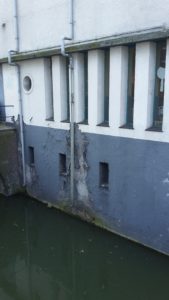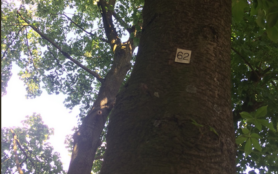Data walk in Utrecht – Identity & identification
After establishing ‘identity and identification’ as lens we started our walk in Utrecht on the Drift. Immediately different markers of identity were observed with the Utrecht University logo being omnipresent. The lampposts were equally designed with the city shield. Our attention was then drawn to the sewer covers, some containing imprints with numbers and others not. Was there a logic to this – was it d evised as a means of identification perhaps? Most university buildings require an access pass for entry, which requires credentials (for identification), separating those employed by Utrecht from the rest of the public. One of the participants took out his University ID card which would open the door for us. Equally interesting was a company, Channable, which on the one hand set its brand in the stone above its entry (‘old fashioned style’, as if to tie in its identity with that of the street or city), but on the other hand featured a device with a fingerprint pad for access to the building (identification state-of-the-art). We then saw graffiti on a trash can and spoke of it as a form of identity expression. Next someone noticed that a building was being affected by the water from the canal and the paint had started to peel. Was this also a form of ‘data’ that somehow contributed to our
evised as a means of identification perhaps? Most university buildings require an access pass for entry, which requires credentials (for identification), separating those employed by Utrecht from the rest of the public. One of the participants took out his University ID card which would open the door for us. Equally interesting was a company, Channable, which on the one hand set its brand in the stone above its entry (‘old fashioned style’, as if to tie in its identity with that of the street or city), but on the other hand featured a device with a fingerprint pad for access to the building (identification state-of-the-art). We then saw graffiti on a trash can and spoke of it as a form of identity expression. Next someone noticed that a building was being affected by the water from the canal and the paint had started to peel. Was this also a form of ‘data’ that somehow contributed to our  reading of the building in terms of it history, which in a way contributed to its identity? This triggered some key questions about the scope of data, esp. in relation to signs (and systems, but also networks of signs vs. systems, networks of data), and about intentional (e.g. university signs and city shield; also stickers with logos for given causes – or not?) and unintentional expressions of identity (paint peel; and again: stickers with logos, or not?). We also discussed how data is connected to categorization, and whether performance is also a form of data (or productive of it) – that can subsequently connect to identity?
reading of the building in terms of it history, which in a way contributed to its identity? This triggered some key questions about the scope of data, esp. in relation to signs (and systems, but also networks of signs vs. systems, networks of data), and about intentional (e.g. university signs and city shield; also stickers with logos for given causes – or not?) and unintentional expressions of identity (paint peel; and again: stickers with logos, or not?). We also discussed how data is connected to categorization, and whether performance is also a form of data (or productive of it) – that can subsequently connect to identity?
We moved along and were struck by ridges in the sidewalk, presumably for the blind. This connected to questions about identity as self-expression and imposed identification (and objectification?). We considered how imposed identification can occur not only in relation to people, but also to trees (numbered) and sewer lids (partly numbered). And also, the relations between performance, modes of behavior, and data – youngsters on scooters blocking the side walk for instance.
At a certain point we walked into what we thought was a data calm side street, only to be confronted by a sign that read that we were visibly and not visibly being monitored. Ano ther presumable data-calm area was a park. But we had been mistaken. There were posts that marked off certain areas: one for picnics and the other for dogs to do their business. The trees all had numbers. Aside from these visible markers we also discussed how we felt like intruders as we walked passed a group of young people just hanging out in the park. We felt this wasn’t our space in some way, as scenography (as a form of data) could be read in this way. The discussion therefore ended with a reflection on “coded space” and the performance of space, and the tactics of (self-)identification of people within the strategies defined by spaces and institutions. We also raised questions about the relations between public, and private space.
ther presumable data-calm area was a park. But we had been mistaken. There were posts that marked off certain areas: one for picnics and the other for dogs to do their business. The trees all had numbers. Aside from these visible markers we also discussed how we felt like intruders as we walked passed a group of young people just hanging out in the park. We felt this wasn’t our space in some way, as scenography (as a form of data) could be read in this way. The discussion therefore ended with a reflection on “coded space” and the performance of space, and the tactics of (self-)identification of people within the strategies defined by spaces and institutions. We also raised questions about the relations between public, and private space.
Conclusion: The city is a striated space where identity is continually being claimed and renegotiated. Herein all types of data (some networked to other knowledge systems in both digital and non-digital form) play a significant role in the establishing of boundaries.

